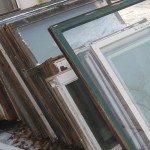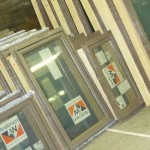ReUse Action is now repairing and rebuilding wooden sash windows. We offer services from re-glazing, glass replacement to full reconstruction from scratch. Give us a call if you’d like to know more.


Why not simply replace with vinyl windows?
Most energy research shows that leaky windows are responsible for most of the heat loss in our houses. This is a difficult subject to find objective facts about because the replacement window industry overwhelmingly dominates the discussion.
A typical vinyl window advertisement highlights the following:
1. Low-U (or high-R) value of the gas-filled double pane glass
2. Low-E glass
3. Maintenance-free, lifetime performance
4. Cheap
5. Environmental benefits of increased energy performance
Being a scientist, I’ve looked into the physics of these claims and it’s not clear to me that claims made by the advertisements are really borne out in the actual day-to-day working setting of windows. Let’s go over vinyl window-makers’ claims one by one:
1. Low-U (or high-R) value of the gas-filled double pane glass
Glass is inherently a good conductor of heat. A high “R” value means it resists heat flowing through it. Windows will never come close to insulated walls in R-values due to the inherent properties of glass – IT CONDUCTS HEAT WELL.
Compare it with a 6½” thick fiberglass batt. The batt (if installed properly!) has an average R-value of about 19. Single pane glass has an R-value of 0.91 (source: www.coloradoenergy.org/procorner/stuff/r-values.htm). This is about 95% less efficient than fiberglass.
Low pressure argon-filled, double and triple-paned windows increase this value to an average R-value of about 2-3. Often advertisements sell this by saying that the insulating value of a new replacement window is 100-150% greater than old windows. Technically true but not a huge difference.
Another factor to look at is how the R-value is measured. The R-value is measured at the center of the glass or between the planes of glass in multiple-paned windows. This is a somewhat ideal situation and does not account for the ENTIRE window; the frames and sashes, joints and construction.
Most green building guides suggest air infiltration is a far bigger affector of our energy bills and feeling of comfort. Simply put when we heat our houses the warm air inflates our homes slightly, like a balloon. The higher indoor pressure pushes air out of any small holes and lets cold air in to replace it. This is physics which cannot be changed and it’s these drafts that make our homes feel cold and raises our heating bills. Returning to R-values, high-R glass with a leaky frame is no savings. Heck, you could put a piece of R-19 fiberglass in the window hole but do no better overall because of the frame.
A PROPERLY MAINTAINED wooden window and storm window can get you an R-value of about 1-1.5! These values can be raised further with curtains and shrink-wrap plastic. In those terms maintaining the older windows is more cost-effective than replacement.
2. Low-E glass
Low E glass is another misunderstood factor. E stands for “emissivity” which is the material’s ability to capture and radiate heat. Compared to a black body (which radiates all absorbed energy) glass is about 95% the same. This is simply a restatement of the fact that glass transmits heat very well as described above. Low-E coatings reduces heat, in the form of infra-red radiation, from entering our homes through the glass.
Low–E coatings reflect infrared radiation away from windows so that it does not get in and warm our homes. In warm areas with high air conditioning usage, where houses must be sealed to be efficiently cooled, this may provide a benefit. In Buffalo or other northern climates, one must consider whether this is a benefit when we have a few weeks of hot weather and nearly six months of low sunlight and cold temperatures. In mild weather when windows are open low-E has little to no effect.
3. Maintenance-free, lifetime performance
Replacement window companies often advertise their windows as having “lifetime performance” and being “maintenance free”. Many objective articles suggest this is not entirely correct. My own personal, and anecdotal experience supports these results.
As stated above a window performs only as efficiently as the quality of the overall window construction – frames sashes, joints, installation, etc.
Vinyl is not immune to ultraviolet sunlight damage. Ultraviolet light from the sun eventually makes ALL plastics brittle. Despite claims of “lifetime performance”, cracking and drying will occur within a few years of exposure. You can’t stop it because it is fundamental physics that cannot be changed. Aluminum, steel and cast iron have been used as alternative frame materials, but physics intervenes again, and more energy is conducted out through these materials than through glass making them especially inefficient!
Heat-welded joints fare better than mechanical joints but still will succumb to UV damage and mechanical stresses from opening and closing. Air will then find its way through the joints – jut as it does with an improperly maintained wooden sash.
From personal experience I have found also that the seals that trap the low pressure gas between the double panes invariably fail. I only have a few vinyl windows and all three lost their seals within a year, and trapped moisture in the gas space. Moisture in the gaps and spaces freezes and further opens them and makes them no more efficient than my properly maintained old windows.
While I do not believe that vinyl or replacement windows are inherently bad, I urge people to critically examine their performance and weigh the costs of fixing or replacing existing windows.
4. Cheap
Cost! This is the nuts and bolts of most arguments, and the topic most subject to manipulation. Replacements range in cost from a few hundred dollars apiece to thousands of dollars each. Quality varies wildly and generally high quality windows are more expensive. Cheap windows are – well – often cheap and perform poorly and for a shorter time. All replacements I’ve ever installed have failed quickly. In my time selling used windows, almost every replacement window had failed and was infiltrated with moisture, even expensive patio doors and windows.
High cost often comes with better materials and workmanship, and better and longer performance. It’s no wonder full historic reconstruction of windows is the most costly option, but they look the best and perform the best, benefiting from the best, most energy-efficient materials (wood!) and modern technological advances such as double-paned glass.
One thing to keep in mind is that existing wooden windows are actually fairly easy to maintain, repair and replace and often it costs less to do it. Additionally if a replacement fails or needs to be replaced it is considerably more expensive and laborious.
And. what if a stray football breaks the glass? One cannot simply remove the old and glaze in a new piece. Glass is relatively cheap and glazing costs a few bucks a quart. When a modern replacement breaks it requires custom ordering a whole new sash, or perhaps a whole new unit from the company that made it. One company’s sashes will not fit or repair another.
Wooden sashes are often interchangeable and can be modified to fit into existing window frames and in the worst cases a new sash or storm window can be fabricated from wood at a cost that is often comparable to a new lower-end replacement window. Again you can order a high-end replacement from a big name manufacturer but expect to pay thousands per unit – not including installation.
Again this is not to knock replacement windows but rather to give consideration of the value of existing windows before paying for the claims of replacement windows. My mom always said “The bitterness of low quality lasts far longer than the sweetness of a cheap deal” and this can be true for replacement windows in a northern climate!
5. Environmental benefits of increased energy performance
Environmentally, replacement windows are sold as a “green” option. Any time something is replaced the waste goes to a landfill. This has a very high environmental cost, including contribution to global climate change, ground and water pollution, and waste of land and resources. Repairing and reusing existing windows, or anything for that matter, is always more environmentally friendly than replacing them.
Most moderate cost replacement windows are made of vinyl which is requires large amounts of petroleum to produce, ship and install. I don’t need to discuss all the problems regarding petroleum but will say it’s clear reductions in our usage of it would greatly benefit our environment and the world at large.
There are some environmental savings from properly working replacement windows but as above it’s dependent on their quality and how well they are maintained. And it should be noted an uninsulated and drafty house with the most expensive windows is still going to be cold and expensive to heat.
Finally, ReUse Action is offering services to repair window sashes, glass, minor repairs all the way to complete fabrication of new sashes and storms. ReUse Action is also accepting wooden window sashes, even if they are in rougher shape. However, we generally do not accept windows with broken glass and we reserve the right to reject any windows not suitable for rebuild or parts. If you have windows you’re looking to see re-used or you have larger window restoration projects please contact us.
